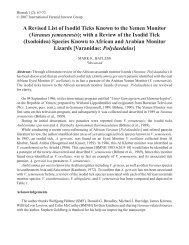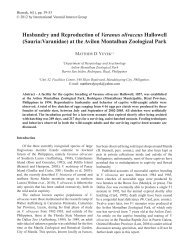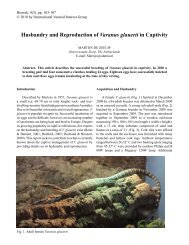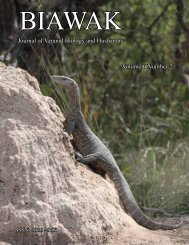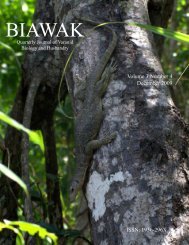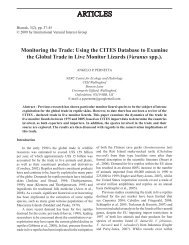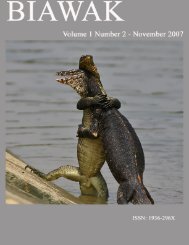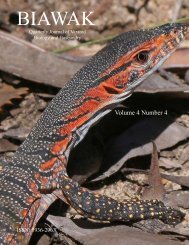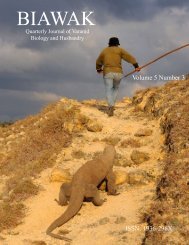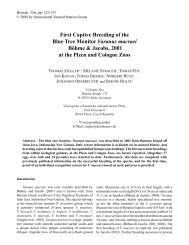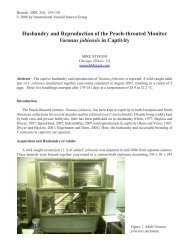Notes on Breeding Varanus albigularis in Captivity - International ...
Notes on Breeding Varanus albigularis in Captivity - International ...
Notes on Breeding Varanus albigularis in Captivity - International ...
Create successful ePaper yourself
Turn your PDF publications into a flip-book with our unique Google optimized e-Paper software.
Biawak 1(2): 73-76<br />
© 2007. Internati<strong>on</strong>al Varanid Interest Group<br />
<str<strong>on</strong>g>Notes</str<strong>on</strong>g> <strong>on</strong> <strong>Breed<strong>in</strong>g</strong> <strong>Varanus</strong> <strong>albigularis</strong> <strong>in</strong> <strong>Captivity</strong><br />
JEAN-MICHEL LE PODER<br />
Oxerstraat 14<br />
7416 Deventer, Netherlands<br />
judraaisma@home.nl<br />
This account describes two successful captive breed<strong>in</strong>g attempts for <strong>Varanus</strong> <strong>albigularis</strong>; the first<br />
occurr<strong>in</strong>g <strong>in</strong> 2000, and the sec<strong>on</strong>d <strong>in</strong> 2006. Different lizards were <strong>in</strong>volved <strong>in</strong> each event.<br />
The two V. <strong>albigularis</strong> <strong>in</strong>volved <strong>in</strong> the first breed<strong>in</strong>g attempt (2000) were a 7 year old male and a 4<br />
year old female, both of which were orig<strong>in</strong>ally wild-caught and unrelated. The m<strong>on</strong>itors were ma<strong>in</strong>ta<strong>in</strong>ed<br />
<strong>in</strong> an apartment where they were free to roam the different rooms. Their primary room offered a shallow<br />
layer (ca. 1 cm deep) of substrate c<strong>on</strong>sist<strong>in</strong>g of a sand and soil mixture atop a c<strong>on</strong>crete floor. Furnish<strong>in</strong>gs<br />
c<strong>on</strong>sisted of large st<strong>on</strong>es and several thick tree branches. Heat and light were provided by six 150 watt<br />
reflector bulbs and four full spectrum bulbs (Zoo Med Laboratories, Inc. San Luis Obispo, CA, USA).<br />
This room’s daytime ambient temperature was ca. 24-26 °C, and bask<strong>in</strong>g temperatures ranged between<br />
35 and 40 °C. Night-time ambient temperature varied between 19 and 21 °C, depend<strong>in</strong>g <strong>on</strong> the seas<strong>on</strong>.<br />
The m<strong>on</strong>itors were fed five times a week <strong>on</strong> a diet of mice, day-old chicks, rats, locusts, and occasi<strong>on</strong>ally<br />
hard-boiled eggs. This diet has proven to be successful after several years, and n<strong>on</strong>e of the m<strong>on</strong>itors have<br />
ever become obese or lethargic. It is felt that feed<strong>in</strong>g quantity and quality are crucial <strong>in</strong> the reproducti<strong>on</strong> of<br />
m<strong>on</strong>itors. Vitam<strong>in</strong> supplementati<strong>on</strong> was added to the food twice weekly, and water was provided daily.<br />
In the first week of May 2000, the male showed typical varanid courtship behavior, c<strong>on</strong>sist<strong>in</strong>g of<br />
spasmodic head movements when approach<strong>in</strong>g the female, and t<strong>on</strong>gue-flick<strong>in</strong>g around the female’s body,<br />
especially <strong>on</strong> the neck and head. This courtship behavior lasted for a week. Intense copulati<strong>on</strong> began<br />
<strong>on</strong> 12 May, and ended 15 May. Copulati<strong>on</strong> did not occur <strong>in</strong> the primary room, but <strong>in</strong>stead took place <strong>in</strong><br />
the adjacent rooms where temperatures were lower, around 20 °C (Figures 1 & 2). On average, mat<strong>in</strong>g<br />
occurred four times a day, with short breaks <strong>in</strong> between where both lizards rested close to each other. After<br />
this three day period, both m<strong>on</strong>itors were observed shelter<strong>in</strong>g together <strong>in</strong> the same hide spot, and showed<br />
no further mat<strong>in</strong>g activity. Both used this area as their primary shelter dur<strong>in</strong>g this period, but also spent<br />
Figures 1 & 2. Copulati<strong>on</strong> of <strong>Varanus</strong> <strong>albigularis</strong>
Biawak 2007 Vol. 1 No. 2<br />
74<br />
nights together <strong>in</strong> various other locati<strong>on</strong>s such as beneath slabs of tree bark positi<strong>on</strong>ed <strong>in</strong> various rooms<br />
of the apartment, and <strong>in</strong> closets. One week later, a large wooden nest<strong>in</strong>g box measur<strong>in</strong>g 180 x 90 x 40 cm,<br />
was placed <strong>in</strong> the primary room. The box was filled with a sand and soil mixture to a depth of ca. 35 cm,<br />
and was left open for easy view<strong>in</strong>g. A 100 watt heat lamp suspended from the ceil<strong>in</strong>g to a height of ca.<br />
30 cm above the nest box was directed down <strong>on</strong>to the nest<strong>in</strong>g substrate, and the substrate moisture levels<br />
were m<strong>on</strong>itored daily. Approximately 4 weeks after the last observed copulati<strong>on</strong>, the female showed a<br />
special <strong>in</strong>terest <strong>in</strong> the nest box by repeatedly digg<strong>in</strong>g <strong>in</strong> it. This behavior lasted for several days, as she<br />
searched for a suitable place to lay. Dur<strong>in</strong>g this time, her appetite decreased, and she refused to feed four<br />
days prior to ovipositi<strong>on</strong>.<br />
Overnight, between 17 and 18 June 2000, the female deposited a clutch of 21 eggs atop the sand and<br />
soil substrate cover<strong>in</strong>g the c<strong>on</strong>crete floor, ignor<strong>in</strong>g the nest box provided (possibly not deep enough).<br />
Dur<strong>in</strong>g ovipositi<strong>on</strong>, the female positi<strong>on</strong>ed herself <strong>in</strong>side a hollow tree trunk with <strong>on</strong>ly her h<strong>in</strong>d limbs and<br />
tail exposed, allow<strong>in</strong>g for perfect view<strong>in</strong>g of the lay<strong>in</strong>g process. The female laid her first egg <strong>on</strong> 17 June<br />
at 2400 h, and her 21st egg <strong>on</strong> 18 June at 0900 h. An additi<strong>on</strong>al 3 eggs were laid between 19 June and 20<br />
June atop the substrate cover<strong>in</strong>g the cement floor. By us<strong>in</strong>g her rear limbs, she carefully pushed each egg<br />
<strong>in</strong>to a pile between her h<strong>in</strong>d limbs. Eggs averaged 7 cm <strong>in</strong> length and 4 cm <strong>in</strong> width. No nest guard<strong>in</strong>g<br />
behavior or aggressi<strong>on</strong> was observed <strong>in</strong> the female towards the male.<br />
All eggs were removed from their site of depositi<strong>on</strong>, and set up for <strong>in</strong>cubati<strong>on</strong> <strong>in</strong> two separate <strong>in</strong>cubators<br />
<strong>in</strong> order to accommodate the entire clutch. Eleven eggs were <strong>in</strong>cubated <strong>in</strong> a Br<strong>in</strong>sea Hatchmaster (Br<strong>in</strong>sea<br />
Products Ltd. North Somerset, England, UK), ma<strong>in</strong>ta<strong>in</strong>ed at 30 °C with a humidity of ca. 70-80%. The<br />
other 13 eggs were placed <strong>in</strong> a plastic c<strong>on</strong>ta<strong>in</strong>er <strong>in</strong>side an aquarium partially filled with water and heated<br />
with a 40 watt heat lamp c<strong>on</strong>nected to a thermostat. The temperatures with<strong>in</strong> the aquarium <strong>in</strong>cubator<br />
ranged between 28-31 °C, and the humidity ranged between 70-95 % . All eggs were partially buried <strong>in</strong> a<br />
water and vermiculite mixture prepared at a ratio of 1:1 by weight (Figure 3).<br />
Of the 24 eggs <strong>in</strong>cubated, 7 successfully hatched; 4 <strong>in</strong> the aquarium <strong>in</strong>cubator after 150 days of<br />
<strong>in</strong>cubati<strong>on</strong>, and 3 <strong>in</strong> the commercial <strong>in</strong>cubator after 180 days of <strong>in</strong>cubati<strong>on</strong>. The 17 eggs which did not<br />
hatch began to look bad towards the end of <strong>in</strong>cubati<strong>on</strong>, and were dissected. One egg c<strong>on</strong>ta<strong>in</strong>ed a dead<br />
embryo, and, the others appeared to be <strong>in</strong>fertile; each c<strong>on</strong>ta<strong>in</strong><strong>in</strong>g a gelat<strong>in</strong>ous, reddish-colored mass. All<br />
seven surviv<strong>in</strong>g hatchl<strong>in</strong>gs emerged from their eggs <strong>on</strong> their own without any assistance over the course<br />
Figure 3. (Partial) Clutch of eggs.<br />
Figure 4. Hatchl<strong>in</strong>g emerg<strong>in</strong>g from egg
Biawak 2007 Vol. 1 No. 2<br />
75<br />
of several days, mostly dur<strong>in</strong>g the night or <strong>in</strong> the early morn<strong>in</strong>g (Figures 4 & 5). Up<strong>on</strong> emerg<strong>in</strong>g, two<br />
hatchl<strong>in</strong>gs had residual yolk sacs and umbilical stalks attached, which so<strong>on</strong> fell off after rubb<strong>in</strong>g their<br />
abdomens <strong>on</strong> the substrate.<br />
All seven hatchl<strong>in</strong>gs (Figure 6) were set up <strong>in</strong> a plexiglass enclosure which offered a floor space area of<br />
100 x 40 cm. At night, hatchl<strong>in</strong>gs sheltered clustered together under a slab of tree bark. Hatch<strong>in</strong>gs began<br />
feed<strong>in</strong>g <strong>on</strong> crickets after 48 h.<br />
The next successful breed<strong>in</strong>g began <strong>in</strong> May 2006. Two unrelated lizards were <strong>in</strong>volved <strong>in</strong> this breed<strong>in</strong>g;<br />
a 6 year old captive-bred female orig<strong>in</strong>at<strong>in</strong>g from the 2000 successful breed<strong>in</strong>g, and an 8 year old male of<br />
wild-caught orig<strong>in</strong>. Both lizards were kept together with eight other adult m<strong>on</strong>itor lizards (7 V. <strong>albigularis</strong>:<br />
4 females and 3 males; and <strong>on</strong>e female V. salvator) <strong>in</strong> a spacious cellar measur<strong>in</strong>g ca. 18.5 m 2 , which was<br />
furnished specifically for the lizards. Shelters, branches, and st<strong>on</strong>es to climb <strong>on</strong> were provided, as well as<br />
a water c<strong>on</strong>ta<strong>in</strong>er large enough to allow the m<strong>on</strong>itors to fully submerge their bodies when needed. As <strong>in</strong><br />
the previous breed<strong>in</strong>g, light<strong>in</strong>g and heat<strong>in</strong>g were provided by five 150 watt reflector bulbs and <strong>on</strong>e 160<br />
watt full-spectrum Power Sun reflector lamp (Zoo Med Laboratories, Inc. San Luis Obispo, CA, USA).<br />
The room’s temperatures were comparable to those offered <strong>in</strong> the 2000 breed<strong>in</strong>g. All copulati<strong>on</strong> occurred<br />
<strong>in</strong> this cellar. Courtship was similar to the 2000 breed<strong>in</strong>g, and lasted for two weeks.<br />
Depositi<strong>on</strong> of 16 eggs occurred at night <strong>on</strong> 2 June 2006, after a gestati<strong>on</strong> period of 30 days from the<br />
last observed copulati<strong>on</strong>. As <strong>in</strong> the previous breed<strong>in</strong>g, the eggs were laid atop the sand substrate, however<br />
no nest<strong>in</strong>g box was provided for this event, based up<strong>on</strong> the previous female’s tak<strong>in</strong>g to lay<strong>in</strong>g atop the<br />
substrate. All 16 eggs were <strong>in</strong>cubated <strong>in</strong> the same Br<strong>in</strong>sea <strong>in</strong>cubator, ma<strong>in</strong>ta<strong>in</strong>ed at 30 °C and 90 %<br />
humidity. This <strong>in</strong>crease <strong>in</strong> humidity from that used <strong>in</strong> the 2000 breed<strong>in</strong>g was not <strong>in</strong>tenti<strong>on</strong>al.<br />
The first egg hatched <strong>on</strong> the night of 19 November 2006, after 180 days of <strong>in</strong>cubati<strong>on</strong>, and by morn<strong>in</strong>g,<br />
the hatchl<strong>in</strong>g had fully emerged from its egg. By 3 December 2006, six more hatchl<strong>in</strong>gs had emerged from<br />
their eggs. The rema<strong>in</strong><strong>in</strong>g n<strong>in</strong>e eggs failed to hatch, and dissecti<strong>on</strong> <strong>on</strong>ce aga<strong>in</strong> revealed that these eggs<br />
were <strong>in</strong>fertile, c<strong>on</strong>ta<strong>in</strong><strong>in</strong>g no develop<strong>in</strong>g embryos.<br />
Although <strong>in</strong>volv<strong>in</strong>g different <strong>in</strong>dividuals, both breed<strong>in</strong>g events were very similar with respect to<br />
observed reproductive behavior and hatch<strong>in</strong>g results. Seven m<strong>on</strong>itors hatched from clutches of 24 and<br />
16 eggs, respectively. A clutch of 25 eggs, laid <strong>on</strong> 24 May 2007, result<strong>in</strong>g from the same pair <strong>in</strong>volved <strong>in</strong><br />
the 2006 breed<strong>in</strong>g, is currently <strong>in</strong>cubat<strong>in</strong>g <strong>in</strong> both <strong>in</strong>cubators used <strong>in</strong> the 2000 breed<strong>in</strong>g. As with previous<br />
Figure 5. Emerg<strong>in</strong>g hatchl<strong>in</strong>g <strong>in</strong> hand<br />
Figure 6. Captive-bred offspr<strong>in</strong>g
Biawak 2007 Vol. 1 No. 2<br />
76<br />
clutches, ovipositi<strong>on</strong> occurred at night, and <strong>on</strong>ce aga<strong>in</strong> the female made use of a hollow tree trunk as cover<br />
while she deposited the eggs atop the substrate.<br />
Despite receiv<strong>in</strong>g healthy hatchl<strong>in</strong>gs from each breed<strong>in</strong>g, the cause for the poor egg viability and<br />
hatch rates experienced <strong>in</strong> both clutches rema<strong>in</strong>s unknown. In the wild, it would be expected that female<br />
m<strong>on</strong>itors deposit their eggs <strong>in</strong> safe, secure areas protected from extreme climatic c<strong>on</strong>diti<strong>on</strong>s and potential<br />
predators. Therefore, deposit<strong>in</strong>g eggs <strong>on</strong> the surface of the substrate is unlikely normal nest<strong>in</strong>g behavior,<br />
and suggests that the nest<strong>in</strong>g opti<strong>on</strong>s provided may be <strong>in</strong>sufficient. Further test<strong>in</strong>g of different nest<strong>in</strong>g<br />
media, depths of media, temperature ranges, and moisture c<strong>on</strong>tent may help resolve this issue, and provide<br />
further <strong>in</strong>sight <strong>in</strong>to the nest<strong>in</strong>g preferences of captive V. <strong>albigularis</strong>.



